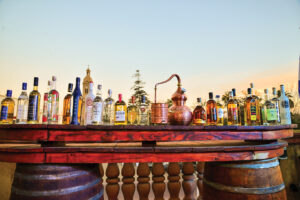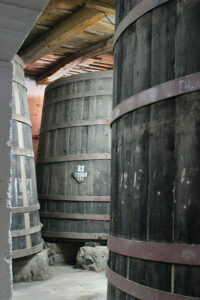T
he City of Yakima’s Water/Irrigation Division provides drinking water and urban irrigation services to around 70,000 urban drinking water users and around 30,000 urban irrigation users. Currently dependent on water from snowpack, the city is implementing aquifer storage and recovery (ASR) strategies as climate change shifts winter precipitation toward rain instead of snow. The city is also working to replace Nelson Dam with a roughened channel diversion, reducing flood risks while benefiting endangered wildlife.
In this interview, David Brown, the assistant public works director and manager of the Water/Irrigation Division, speaks with Irrigation Leader Editor-in-Chief Kris Polly about the division’s services and current projects.

Joshua Dill: Tell us about the Pisco Producers’ Association.
Francisco Hernández: Most businesses that produce pisco today form part of the Pisco Producers’ Association (Asociación de Productores de Pisco A.G.), which represents the industry’s interests and promotes the historical, cultural, and economic value of our pisco traditions under the aegis of the Denomination of Origin appellation system. Formed in 2003, the organization continues to strengthen its work in response to the need for an entity of reference that advocates for the interests of businesses in the sector and that can serve as a worthy participant in the public-private dialogues that arise in the context of the sector’s development.
Over the last years, the association has centered its efforts on the diffusion of pisco and awareness of its origins, its characteristics, its production process, and its status as an economic motor across centuries and generations.
We pisco producers want to bring our product to the world and have our eyes fixed on the great world markets. In 2018, we had a tremendous international presence, thanks to the support of institutions like ProChile, which has become a great ally in the diffusion of pisco. We have held tastings, master classes, cocktail shows, and other activities in a series of priority markets like Argentina, Brazil, England, Poland, Russia, Spain, and the United States. We are happy with the results we have obtained from these activities, and we hope to continue this strategy this year, taking on more markets and promoting pisco in bars and restaurants.

In the countries where we are active, we are always satisfied with the recognition, praise, and awards that pisco receives. A pisco even received the distinction of “Best in Show Unaged White Spirit” at the San Francisco World Spirits Competition. Vinalies Internationales determined that one of our piscos was the best distilled fruit spirit in the world. Pisco triumphs in competitions like these and as a result is highly valued by bartenders and sommeliers around the world.
Joshua Dill: Please give us an overview of the cultivation of pisco grapes in Chile.
Francisco Hernández: Its history begins with a big mistake: Looking for a new route to the Indies, Christopher Columbus stumbled upon the New World, sparking an intense interchange of products, cultures, and visions. The Spanish colonizers brought with them European plants and animals in order to be able to guarantee access to their accustomed foods in their life in the New World.
Spanish grapevines adapted with surprising rapidity to our fertile soils, producing much more wine than was necessary for the celebration of Mass and the process of evangelization. This is how a flourishing wine-producing industry started up in the Spanish colonies, especially in the Viceroyalties of Peru and the Río de la Plata.
In 1549, the Chilean city of La Serena was refounded and the first vineyards were planted in its outskirts, which later extended to the valleys of Copiapó, Huasco, Elqui, Limarí, and Choapa. The unique characteristics of these lands permitted the production of wines of high quality and intense sweetness. But precisely this sweetness posed problems for the transportation of this prized product, since it deteriorated rapidly.
As a way to preserve the wine and to reduce the total volume to be transported, producers began to extract the alcohol from the wine. This process, known as distillation, was promoted by the presence of copper and copperwork specialists, known as forgers (fragüeros). They forged the copper stills that are still the soul of pisco. The liquor was stored in fired-clay jugs called piscos, which were created by the indigenous people of an area that is now part of Peru and Chile. Then it traveled far and wide to supply the vast mining areas of the Viceroyalty of Peru.

Joshua Dill: How are pisco grapes different from other sorts of grapes?
Francisco Hernández: Pisco inherits a centuries-long tradition of distillation. History and modernity converge in its production, meeting the highest standards of quality, whether it is made by a small boutique distillery or a big business. These standards revolve around two important criteria: the Pisco Denomination of Origin and the raw materials used in its production.
The Pisco Denomination of Origin appellation reflects the factors and characteristics that intimately link this distilled spirit with the geography and culture of the transverse valleys of Copiapó, Huasco, Elqui, Limarí, and Choapa. Then there are pisco grapes, which emerged from the convergence of a variety of grape stocks, which produced new, indigenous varieties in these fertile soils. There are 10,000 hectares of pisco grapes in Chile. The majority are devoted to plantings of Moscatel Rosada, Moscatel de Alejandría, Moscatel de Austria, Torontel, and Pedro Jiménez. There are also other, lesser-used varieties of pisco grapes: Moscatel Temprana, Amarilla, Canelli, Frontignan, Hamburgo, Negra, Orange, and Chasselas Musque Vrai. Grown at the foot of the desert, with cold nights and a lot of sun, these grapes have a high level of sugar.
A single bottle of pisco requires approximately 3.5 kilos of pisco grapes, and months of work, rest, and dedication from approximately 3,000 farmers. That means that each bottle of pisco is the fruit of thousands of small- and medium-scale farmers. The pisco industry maintains strict standards of quality delineated by the Decree in Force of Law 181 of 1931. This decree granted pisco its Denomination of Origin, the second oldest in the world and the first in the Americas. This is how our pisco, its production process, its geographical specifications, and especially its name are protected by law.

Joshua Dill: What role does irrigation play in the cultivation of pisco grapes?
Francisco Hernández: Irrigation plays a fundamental role, given that we are at the border of the Atacama Desert. Without irrigation, no crops could be grown. Moreover, the development of the pisco grape has led to the implementation of an irrigation system that has also made possible the cultivation of avocados, citrus fruit, and table grapes, among other crops.
Joshua Dill: What are the most important challenges grape growers face in Chile?
Francisco Hernández: For generations, our profession has had to prevail against adversity and severe conditions, bringing our bravery and resolve to bear against the challenges and obstacles in the path of preserving the traditions and culture of one of Chile’s oldest products. With firmness and optimism, we defend pisco, which is part of the historic, social, cultural, and economic patrimony of all Chileans.
Joshua Dill: What are the association’s top issues today?
Francisco Hernández: Our mission is to bring together and to represent the whole pisco-producing family in an equitable manner, showing no favoritism to any brand, and strengthening the image and recognition of pisco. On the national level, our work centers around raising awareness of the value of what pisco producers do and of pisco’s place as part of the historic, social, cultural, and economic patrimony of all Chileans. On the international level, we are pursuing the mission of positioning Chilean pisco as a premium product and experience in primary markets.
Our objectives revolve around protecting and promoting of the Pisco Denomination of Origin at the national and international levels and raising awareness of the history and unique characteristics of the product. We support research, technological development, and innovation to strengthen the pisco industry’s value chain and work for the improvement and the suitability of the regulatory framework for the development and sustainability of the industry.
Joshua Dill: What is your vision for the future?
Francisco Hernández: The pisco industry has had an important boost in the last few years, as evidenced by the great number of new brands that have entered the market since 2010. These new brands seek to provide a product of the highest quality, with a production process that strictly observes the regulations contained in the Pisco Denomination of Origin of 1931, but that also seeks to satisfy new consumers and the requirements of new trends in mixology.
Francisco Hernández is president of the Pisco Producers’ Association. For more information, visit piscochile.com.
